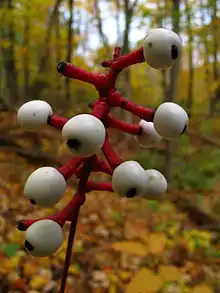Actaea pachypoda
Actaea pachypoda, the white baneberry or doll's-eyes, is a species of flowering plant in the genus Actaea, of the family Ranunculaceae.
| Actaea pachypoda | |
|---|---|
.jpg.webp) | |
| flowers and leaves | |
| Scientific classification | |
| Kingdom: | Plantae |
| Clade: | Tracheophytes |
| Clade: | Angiosperms |
| Clade: | Eudicots |
| Order: | Ranunculales |
| Family: | Ranunculaceae |
| Genus: | Actaea |
| Species: | A. pachypoda |
| Binomial name | |
| Actaea pachypoda | |
The plant is native to eastern North America, in eastern Canada, and the Midwestern and Eastern United States. It prefers clay to coarse loamy upland soils, and is found in hardwood and mixed forest stands.
Description
This herbaceous perennial plant grows to 50 cm (1.6 ft) or more tall. It has toothed, bipinnate compound leaves up to 40 cm (16 in) long and 30 cm (12 in) broad.

The white flowers are produced in spring in a dense raceme about 108 cm (43 in) long. Its most striking feature is its fruit, a 1 cm (1⁄2 in) diameter white berry, whose size, shape, and black stigma scar give the species its other common name, "doll's eyes". The pedicels on which the berries grow are thicker than those of the related species, red baneberry (Actaea rubra). This is the reason for the specific name pachypoda, which means "thick foot",[1] from Ancient Greek παχύς pakhús "thick" and πούς poús "foot". The pedicels thicken and become bright red as the berries develop.[2]
The berries ripen over the summer, turning into fruits that persists on the plant until frost.
There are pink- and red-berried plants that have been called A. pachypoda forma rubrocarpa, but some of them produce infertile seed, and may actually be hybrids with Actaea rubra.[3]
Toxins
Both the berries[4] and the entire plant are considered poisonous to humans. The berries contain cardiogenic toxins which can have an immediate sedative effect on human cardiac muscle tissue, and are the most poisonous part of the plant. Ingestion of the berries can lead to cardiac arrest and death.
The berries are harmless to birds, the plant's primary seed dispersers.
Cultivation
Actaea pachypoda is cultivated as an ornamental plant, in traditional and wildlife gardens.
It requires part or full shade, rich loamy soil, and regular water with good drainage to reproduce its native habitat.[5]
See also
References
- Tenaglia, Dan. "Actaea_pachypoda_page". Missouri Plants. Archived from the original on 2007-09-27. Retrieved 2006-06-18.
- Chayka, Katy; Dziuk, Peter (2016). "Actaea pachypoda (White Baneberry)". Minnesota Wildflowers.
- Ford, Bruce A. (1997). "Actaea pachypoda". In Flora of North America Editorial Committee (ed.). Flora of North America North of Mexico (FNA). 3. New York and Oxford – via eFloras.org, Missouri Botanical Garden, St. Louis, MO & Harvard University Herbaria, Cambridge, MA.
- Niering, William A.; Olmstead, Nancy C. (1985) [1979]. The Audubon Society Field Guide to North American Wildflowers, Eastern Region. Knopf. p. 725. ISBN 0-394-50432-1.
- "RHS Plant Selector - Actaea pachypoda". Retrieved 7 July 2013.
- Karen Legasy, Shayna LaBelle-Beadman and Brenda Chambers. Forest Plants of Northeastern Ontario. Lone Pine Publishing / Queen's Printer for Ontario, 1995.
- Edible and Medicinal plants of the West, Gregory L. Tilford, ISBN 0-87842-359-1
- Ali, Zulfiqar; Khan, Shabana I.; Pawar, Rahul S.; Ferreira, Daneel; Khan, Ikhlas A. (2007). "9,19-Cyclolanostane Derivatives from the Roots of Actaea pachypoda". Journal of Natural Products. 70 (1): 107–10. doi:10.1021/np060152t. PMID 17253859.
- Pellmyr, Olle (1985). "The Pollination Biology of Actaea pachypoda and A. Rubra (Including A. Erythrocarpa) in Northern Michigan and Finland". Bulletin of the Torrey Botanical Club. 112 (3): 265–273. doi:10.2307/2996542. JSTOR 2996542.
- Nuntanakorn, Paiboon; Jiang, Bei; Yang, Hui; Cervantes-Cervantes, Miguel; Kronenberg, Fredi; Kennelly, Edward J. (2007). "Analysis of polyphenolic compounds and radical scavenging activity of four American Actaea species". Phytochemical Analysis. 18 (3): 219–28. doi:10.1002/pca.975. PMC 2981772. PMID 17500365.